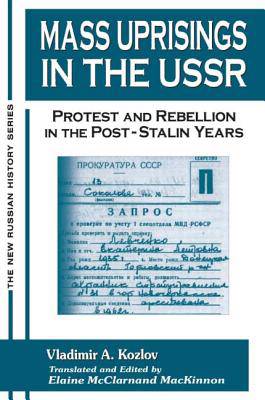
- Afhalen na 1 uur in een winkel met voorraad
- Gratis thuislevering in België vanaf € 30
- Ruim aanbod met 7 miljoen producten
- Afhalen na 1 uur in een winkel met voorraad
- Gratis thuislevering in België vanaf € 30
- Ruim aanbod met 7 miljoen producten
Zoeken
Mass Uprisings in the USSR
Protest and Rebellion in the Post-Stalin Years
V A Kozlov, Elaine McClarnand
€ 90,45
+ 180 punten
Uitvoering
Omschrijving
Until recent times, incidents of mass unrest in the USSR were shrouded in official secrecy. Now this pioneering work by historian Vladimir A. Kozlov has opened up these hidden chapters of Soviet history. It details an astonishing variety of widespread mass protest in the post-Stalin period, including workers' strikes, urban riots, ethnic and religious confrontations, and soldiers' insurrections. Kozlov has drawn on exhaustive research in police, procuracy, KGB, and Party archives to recreate the violent major uprisings described in this volume. He traces the historical context and the sequence of events leading up to each mass protest, explores the demographic and psychological dynamics of the situation, and examines the actions and reactions of the authorities. This painstaking analysis reveals that many rebellions were not so much anti-communist as essentially conservative in nature, directed to the defense of local norms being disturbed by particular instances of injustice or by the rash of Krushchev-era reforms. This insight makes the book valuable not only for what it tells us about postwar Soviet history, but also for what it suggests about contemporary Russian society as well as popular protests in general.
Specificaties
Betrokkenen
- Auteur(s):
- Uitgeverij:
Inhoud
- Aantal bladzijden:
- 336
- Taal:
- Engels
- Reeks:
Eigenschappen
- Productcode (EAN):
- 9780765606686
- Verschijningsdatum:
- 31/07/2002
- Uitvoering:
- Paperback
- Formaat:
- Trade paperback (VS)
- Afmetingen:
- 151 mm x 230 mm
- Gewicht:
- 512 g

Alleen bij Standaard Boekhandel
+ 180 punten op je klantenkaart van Standaard Boekhandel
Beoordelingen
We publiceren alleen reviews die voldoen aan de voorwaarden voor reviews. Bekijk onze voorwaarden voor reviews.











